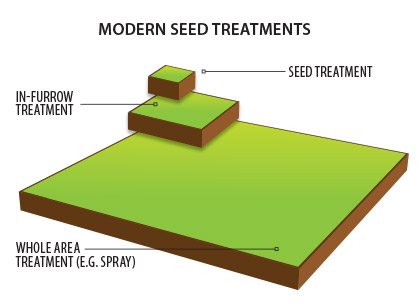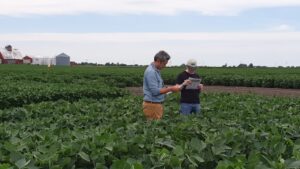
Even though they actually offer a number of benefits to farmers and the environment, seed treatments have been given a black eye during the past few years. Germination spotlights the truth about seed treatments.
Seed treatments have been around for more than 100 years, but it hasn’t been until the past decade that farmers have rapidly adopted the use of them across multiple crops and millions of acres throughout North America.
Ten years ago, most Canadian farmers were using crop protectants as a foliar spray post-emergence over entire fields, which leaves beneficial insects and surrounding specialty crops or landscaping subject to spray drift if not applied properly.
The scientific advancements in the seed coatings industry have allowed seed to be a key delivery method of fungicides, insecticides and stimulants. Seed treatments have provided benefits with respect to health and safety, profitability, crop health and the environment. Experts highlight a few talking points that you can rely on when approached about the overall effects of seed treatments.
Talking Point No. 1: Health and Safety
Most of today’s seed treatments are water-based and come in ready-to-apply formulations. According to Alberta Agriculture and Rural Development, this allows the seed treatment applicator to handle the product with more ease and makes cleaning the treating equipment easier, too. Not only are they easier to use, but also farmers are not in danger of serious chemical exposure as they are with broad applications, which require the use of protective clothing to prevent chemical burns and precautions taken to avoid fumes. While farmers still need to use caution when handling treated seed to avoid dust that might occur when opening a bag, the risks have been minimized.
Talking Point No. 2: The Environment
Seed treatments are not subject to spray drift, whereas the traditional foliar or pre- and post-emergence field applications are. Kevin Nixon, an Alberta beekeeper, says the use of neonicotinoid treated seeds seems to have reduced that exposure risk to the bees and keeps the treatment in the ground. “If farmers had to go back to foliar applications, it would be devastating to beekeepers in Alberta,” he says.
Seed treatments offer precision targeting. CropLife Canada’s Pierre Petelle, vice-president of chemistry, says one example is the use of seed treatments on soybean seeds. “Seed treatments have almost eliminated the need for insecticidal applications for controlling aphid populations,” Petelle explains. “While the efficacy of the seed treatment doesn’t last the whole growing season, growers have reported that fields develop their own ecosystem that takes care of itself.” Basically, the seed treatment provides aphid control at the beginning of the growing season, but it doesn’t harm other beneficial insects, unlike a foliar application, which kills all pests — target and non-target. As the treatment wears off, the beneficial insects prey upon the aphids, providing a more natural control method.
Seed treatments provide targeted protection against insect damage and reduce the potential of exposure to beneficial insects. “One of the advantages of treated seed is that the amount of active ingredient used is often one-tenth of what would be applied as part of a broadcast spray,” Petelle says. “Also, the amount of the environment exposed to the active ingredient is often less than one per cent of what is exposed in the case of a broadcast spray.”
Talking Point No. 3: Crop Health
According to a report by CropLife Foundation that looks at the role of seed treatment in modern crop production, “seed varieties developed through modern breeding techniques, combined with effective seed treatment, provide nearly 100 per cent crop stand — almost every seed produces a mature plant.”
Seed treatments help to ensure uniform stand establishment by protecting against soil-borne pathogens and insects. According to a pesticide applicator’s manual, they are considered so essential for corn stand establishment that virtually all corn seed is treated. Seed treatments have essentially been responsible for eradicating seed-borne pathogens, such as smut or bunt from wheat, barley and oats. They can also help suppress root rots in certain crops.
“Yields of spring wheat and spring barley increased by 25 per cent following the application of seed treatment,” according to trials conducted at Montana State University, reports CropLife Foundation.
Talking Point No. 4: Profitability
The profitability of the use of a seed treatment product comes in the form of a healthier crop, which leads to higher yields. Not only that, but the amount of pesticides farmers are using dramatically decreases, which also reduces their expenses from a crop protection standpoint. But because this reduces the need for a foliar application, farmers also save on fuel, labour and equipment costs.
Michael Grant, a co-author of Seeds for Success: The Value of Seed Treatment for Ontario Growers, estimates that just in Ontario, the absence of neonicotinoid treated seeds would decrease farmers’ revenues by $630 million annually and reduce gross domestic product by nearly $440 million.
All pesticides, including seed treatments, in Canada are regulated by Health Canada’s Pest Management Regulatory Agency, which does a comprehensive scientific review and risk assessment of more than 200 separate studies that test a range of health and environmental impacts before it will approve a pest control product for sale.
Overall, new seed treatments are more effective, control a broader range of pests and are much safer to use for both the applicator and the environment. “Seed treatments are still an emerging technology and will continue to grow,” Petelle says. “Research is really at its infancy in terms of what we can do at the seed level versus the field level.”
According to a recent Research and Markets report, Canada’s seed treatment market is projected to reach $81.2 million by 2020 at a compound annual growth rate of 5.8 per cent from 2014 to 2020, but Petelle says these numbers might be low based off global estimates and Canada’s overall market share.
Julie Deering














